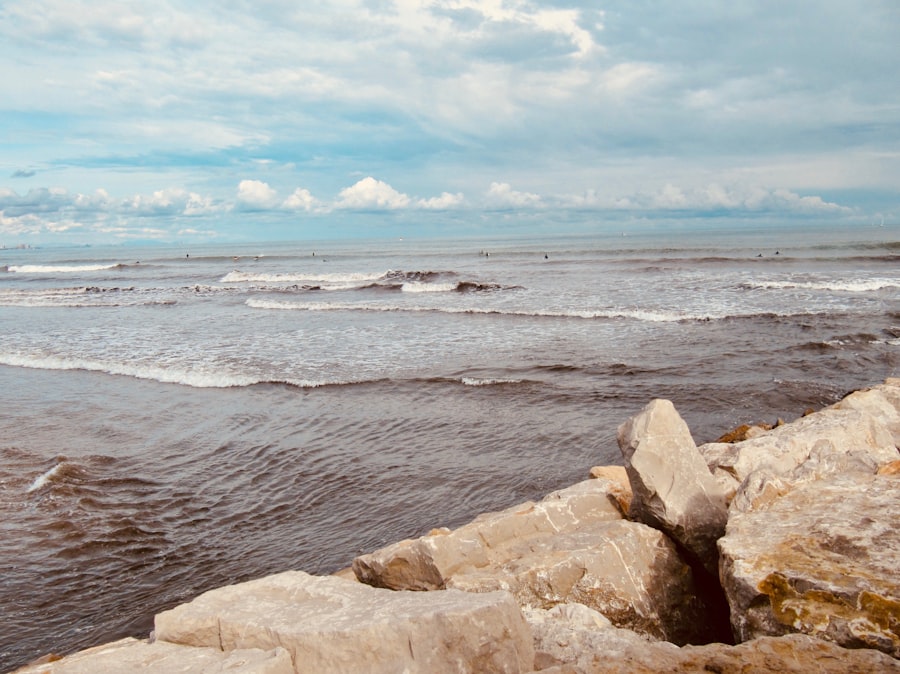New York City, a vibrant metropolis known for its iconic skyline and bustling streets, faces an increasingly pressing challenge: rising sea levels. This phenomenon, driven primarily by climate change, poses a significant threat to the city’s infrastructure, economy, and the safety of its residents. As the world grapples with the consequences of global warming, New York City stands at the forefront of this crisis, with its unique geography making it particularly vulnerable to the encroaching waters.
The urgency of addressing this issue cannot be overstated, as the implications extend far beyond the immediate physical threats to the city. The rising sea levels are not merely a distant concern; they are a reality that New Yorkers are beginning to experience firsthand. Coastal flooding, more frequent and severe storms, and the erosion of shorelines are becoming increasingly common occurrences.
The city’s low-lying areas are at risk of inundation, and the potential for catastrophic flooding events looms large. As scientists and policymakers work to understand and combat this phenomenon, it is crucial for residents to be informed about the risks and the measures being taken to safeguard their city.
Key Takeaways
- Rising sea levels in New York City are a result of climate change and pose a significant threat to the city’s infrastructure and population.
- Vulnerable areas in New York City, such as Lower Manhattan and parts of Brooklyn and Queens, are at high risk of flooding and damage from rising sea levels.
- Current efforts to mitigate the effects of rising sea levels in New York City include infrastructure upgrades, coastal protection measures, and green infrastructure projects.
- The economic impact of rising sea levels on New York City is substantial, with potential costs of billions of dollars in damage to buildings, transportation systems, and utilities.
- Potential solutions to protect New York City from sea level rise include building seawalls, elevating buildings, and implementing green infrastructure to absorb floodwaters.
The Impact of Climate Change on Sea Levels
Climate change is a multifaceted issue that has far-reaching effects on the environment, and one of its most alarming consequences is the rise in sea levels. The primary drivers of this phenomenon include the melting of polar ice caps and glaciers, as well as the thermal expansion of seawater as it warms. As global temperatures continue to rise, these processes accelerate, leading to higher sea levels that threaten coastal cities worldwide.
In New York City, projections indicate that sea levels could rise by several feet by the end of the century if current trends continue. The implications of rising sea levels are profound. Increased flooding can lead to significant damage to infrastructure, homes, and businesses, while also posing risks to public health and safety.
Moreover, saltwater intrusion into freshwater supplies can compromise drinking water quality and agricultural productivity. The economic ramifications are equally concerning, as the costs associated with disaster response, infrastructure repair, and loss of property can strain local and state budgets. As climate change continues to unfold, it is imperative for New York City to develop strategies that address these challenges head-on.
Vulnerable Areas in New York City

Certain neighborhoods in New York City are particularly susceptible to the impacts of rising sea levels. Areas such as Lower Manhattan, Red Hook in Brooklyn, and parts of Queens are at heightened risk due to their proximity to the waterfront and their low elevation.
The devastation wrought by Sandy highlighted not only the immediate dangers posed by storm surges but also the long-term vulnerabilities that these areas face as sea levels continue to rise. In addition to physical vulnerability, these neighborhoods often house economically disadvantaged populations who may lack the resources to adequately prepare for or recover from flooding events. This intersection of socioeconomic factors and environmental risk creates a complex challenge for city planners and policymakers.
Addressing these vulnerabilities requires a comprehensive approach that considers both the physical infrastructure and the social fabric of these communities.
Current Efforts to Mitigate the Effects of Rising Sea Levels
| Country | Efforts | Investment |
|---|---|---|
| United States | Building sea walls and levees | 10 billion |
| Netherlands | Developing innovative water management systems | 1.2 billion |
| Japan | Implementing coastal forestation projects | 5.6 billion |
In response to the growing threat of rising sea levels, New York City has initiated a range of efforts aimed at mitigating its effects. One notable initiative is the city’s comprehensive resilience strategy, which includes investments in infrastructure improvements designed to withstand flooding and storm surges. Projects such as the East Side Coastal Resiliency Project aim to create protective barriers while enhancing public spaces along the waterfront.
These efforts not only seek to safeguard against flooding but also aim to improve the overall quality of life for residents. Additionally, New York City has embraced green infrastructure solutions that promote natural systems as a means of flood mitigation. Initiatives such as creating green roofs, expanding urban parks, and restoring wetlands can help absorb excess rainwater and reduce runoff into storm drains.
By integrating nature-based solutions into urban planning, the city aims to create a more resilient environment that can adapt to changing conditions while also providing ecological benefits.
The Economic Impact of Rising Sea Levels on New York City
The economic implications of rising sea levels for New York City are staggering. As one of the world’s major financial centers, any disruption caused by flooding or storm damage can have ripple effects that extend far beyond its borders. Businesses may face increased operational costs due to damage or disruptions in supply chains, while property values in vulnerable areas may decline as buyers become more aware of flood risks.
The potential for increased insurance premiums further complicates matters for homeowners and businesses alike.
The economic vitality of New York City relies heavily on its ability to attract visitors from around the globe; thus, ensuring that the city remains accessible and safe is paramount.
As local governments grapple with these challenges, they must also consider how best to allocate resources for both immediate response efforts and long-term resilience planning.
Potential Solutions to Protect New York City from Sea Level Rise

To effectively combat rising sea levels, New York City must explore a variety of potential solutions that encompass both technological innovations and community engagement. One promising approach involves investing in advanced engineering solutions such as sea walls and tidal barriers designed to protect vulnerable areas from storm surges. These structures can provide immediate protection against flooding while also serving as critical infrastructure during extreme weather events.
In addition to hard engineering solutions, community-based initiatives play a vital role in fostering resilience. Engaging local residents in preparedness efforts can empower them to take proactive measures in safeguarding their homes and neighborhoods. Educational programs that inform residents about flood risks and encourage participation in local planning processes can help build a culture of resilience within communities.
By combining technological advancements with grassroots engagement, New York City can create a multifaceted approach to addressing rising sea levels.
The Role of Government and Policy in Addressing Rising Sea Levels
Government action is essential in addressing the challenges posed by rising sea levels in New York City. Policymakers must prioritize climate resilience in urban planning and development decisions while also ensuring that funding is allocated toward necessary infrastructure improvements. Comprehensive policies that integrate climate considerations into zoning laws and building codes can help mitigate future risks associated with flooding.
Furthermore, collaboration between various levels of government—local, state, and federal—is crucial for effective response efforts. By working together, agencies can share resources, expertise, and data that inform decision-making processes. Additionally, public-private partnerships can leverage private sector innovation and investment in resilience projects, creating a more robust framework for addressing climate-related challenges.
The Importance of Public Awareness and Education
Public awareness and education are critical components in the fight against rising sea levels. Residents must be informed about the risks they face and empowered to take action within their communities. Educational campaigns that highlight the importance of preparedness can foster a sense of agency among individuals who may feel overwhelmed by the scale of the problem.
Moreover, engaging local organizations and community leaders in outreach efforts can help ensure that information reaches diverse populations across the city. By promoting dialogue around climate change and its impacts on daily life, New York City can cultivate a more informed citizenry that is better equipped to advocate for necessary changes at both local and governmental levels.
The Future of New York City in the Face of Rising Sea Levels
As New York City looks toward the future, it must confront the reality that rising sea levels will continue to pose significant challenges for generations to come. However, with proactive planning and community engagement, there is potential for transformation rather than despair. By prioritizing resilience in urban development and fostering a culture of preparedness among residents, New York City can emerge as a model for other coastal cities facing similar threats.
The future will require adaptability and innovation as climate conditions evolve. Embracing new technologies and sustainable practices will be essential in creating an urban landscape that can withstand environmental changes while continuing to thrive economically and socially.
The Global Implications of Rising Sea Levels
The issue of rising sea levels extends far beyond New York City; it is a global crisis affecting coastal communities worldwide. As cities grapple with similar challenges, there is an opportunity for collaboration and knowledge-sharing on an international scale. Lessons learned from New York’s experiences can inform strategies in other vulnerable regions facing similar threats from climate change.
Moreover, addressing rising sea levels requires collective action on a global level. Countries must work together to reduce greenhouse gas emissions while investing in sustainable practices that protect vulnerable populations from climate impacts. The interconnectedness of today’s world means that local actions can have far-reaching consequences; thus, fostering global cooperation is essential for creating a more resilient future.
Taking Action to Protect New York City from Sea Level Rise
In conclusion, rising sea levels present an urgent challenge for New York City that demands immediate attention and action from all sectors of society. From government officials to community members, everyone has a role to play in addressing this pressing issue. By investing in infrastructure improvements, promoting public awareness, and fostering collaboration across various stakeholders, New York City can take meaningful steps toward safeguarding its future.
The time for action is now; complacency will only exacerbate vulnerabilities as climate change continues its relentless march forward. Through collective efforts aimed at resilience-building and proactive planning, New York City has the potential not only to protect itself from rising waters but also to serve as an example for other cities facing similar threats around the globe.
Rising sea levels pose a significant threat to coastal cities like New York, where the impacts of climate change are becoming increasingly evident. As the city grapples with the challenges of protecting its infrastructure and communities, understanding the broader implications of these environmental changes is crucial. For more insights into how rising sea levels are affecting urban areas and the strategies being implemented to mitigate these effects, you can explore a related article on MyGeoQuest. This resource provides valuable information on the ongoing efforts to address the challenges posed by climate change in coastal regions.
WATCH THIS! The Real Cost of NYC Living: Your Wallet, Sanity, and Subway Survival Skills
FAQs
What are the main causes of rising sea levels in New York?
The main causes of rising sea levels in New York are the melting of polar ice caps and glaciers due to global warming, as well as the thermal expansion of seawater.
How much have sea levels risen in New York?
Sea levels in New York have risen by about 1.2 inches per decade since 1900, which is higher than the global average.
What are the potential impacts of rising sea levels on New York?
Rising sea levels in New York could lead to increased flooding, erosion of coastal areas, and damage to infrastructure such as roads, buildings, and utilities.
What measures are being taken to address rising sea levels in New York?
New York City has implemented a comprehensive climate resiliency plan, which includes measures such as building seawalls, restoring wetlands, and improving stormwater management to mitigate the impacts of rising sea levels.
What can individuals do to help mitigate the effects of rising sea levels in New York?
Individuals can help mitigate the effects of rising sea levels in New York by reducing their carbon footprint, supporting sustainable infrastructure projects, and advocating for policies that address climate change.
